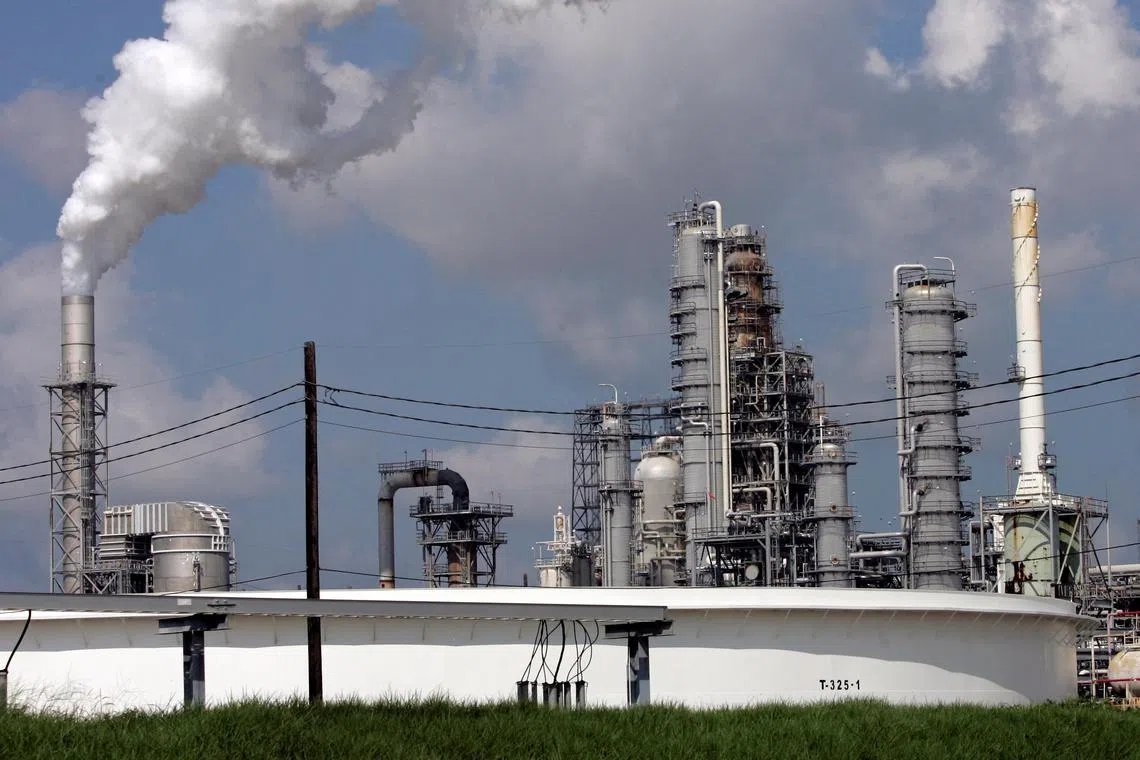US and China on climate: How the world’s two largest polluters stack up
Sign up now: Get insights on Asia's fast-moving developments

The US is a top oil exporter and also consumes 20 per cent of the world’s oil.
PHOTO: REUTERS
Follow topic:
BEIJING – Mr John Kerry, US President Joe Biden’s climate change envoy, wrapped up high-level talks with Chinese officials
The United States and China are the world’s largest greenhouse gas emitters as well as the world’s green tech powerhouses. If they can agree to speed up plans to cut greenhouse gas emissions, it could be consequential for the world’s ability to stay within safe limits of global warming.
But there are significant hurdles, including longstanding tensions over China’s insistence that it is a developing country that should have more leeway to pollute, and US efforts to challenge China’s dominance in clean technology manufacturing.
In recent years, Chinese officials have also warned that broader disputes in the bilateral relationship, which Beijing has blamed largely on the US, will undermine cooperation on combating climate change.
Here are some figures that illustrate the two sides’ complex energy relationship.
Greenhouse gas emissions – past and future
China, the world’s biggest emitter of carbon dioxide, produces 12.7 billion tonnes of emissions annually. That dwarfs US emissions, currently about 5.9 billion tonnes annually. Still, those numbers do not tell the whole story.
Since 1850, China has emitted 284 billion tonnes of carbon dioxide. But the US, which industrialised earlier, has released almost twice that amount: 509 billion tonnes of emissions. In the climate negotiations, cumulative emissions are considered a point of accountability: Countries with higher historic emissions have a higher burden of responding.
The average Chinese person uses far less energy than the average American, about 10.1 tonnes of carbon pollution annually compared with 17.6 tonnes in the US, according to analyses from the research firm Rhodium Group.
Climate targets, climate progress
Under the Obama administration, the US agreed to cut emissions to at least 26 per cent below 2005 levels by 2025. Mr Biden beefed up that target, promising to slash emissions by 50 per cent to 52 per cent from those levels by the end of the decade. The US also promised to
stop new emissions by 2050.
China promised in the Paris Agreement to reach its peak emissions by 2030. It also pledged to raise the share of its non-fossil fuel energy, like wind, solar and nuclear, to 25 per cent. In 2021, its President Xi Jinping said the country would become carbon-neutral by 2060.
Analysts have said the US has put itself within striking distance of meeting its 2030 goal with new laws and regulations. Those include US$370 billion (S$490 billion) in clean energy investments through the
Inflation Reduction Act, which Mr Biden signed in 2022
,
and pending restrictions on emissions from vehicle tailpipes and electricity generation.China is also on track to meet its near-term goals, despite a significant recent uptick in the construction of coal-fired power plants. It has included domestic climate targets in its most recent five-year plan, including ensuring zero-emission fuels make up 25 per cent of energy consumption and half of installed generation.
Oil, gas and coal
The US consumes 20 per cent of the world’s oil, and China consumes about 14 per cent. The US is also a top oil exporter. China imports most of its oil.
In the US, a shift from coal to natural gas, a cheaper resource, has helped lower greenhouse gas emissions. Natural gas now accounts for about 30 per cent of energy use there. In China, natural gas, most of it imported, accounts for 9 per cent of its energy mix, according to the US Energy Information Administration.
The US has not built a new coal plant since 2013. There has been a 40 per cent decline in coal-fired power generation in America over the last decade, according to the Energy Information Administration. China burns more coal than the rest of the world combined. A study in 2022 found that China permitted a total of 106 gigawatts (GW) of new coal power projects in 2022, the equivalent of two large coal power plants per week.
Wind, solar and EVs
China manufactures more
solar panels, wind turbines and electric vehicle (EV) batteries
than any other nation. In 2022, it invested US$546 billion in clean energy. The US invested US$141 billion.China’s renewables capacity surpassed 1,000GW in 2021, four times what it had a decade earlier. Wind and solar now exceed 300GW each, and forecasts predict the country will add up to 150GW soon. Hydropower accounts for 16 per cent of China’s power generation, and nuclear energy provides 5 per cent. And one in four cars sold in China in 2022 was an EV.
In the US, wind, solar, hydroelectric and other forms of renewable power accounted for 21 per cent of the energy mix in 2021. One in 17 new cars sold in the US in 2022 was electric.
Under the Inflation Reduction Act, the US is poised to invest US$370 billion over 10 years in wind, solar, green hydrogen, nuclear energy and other non-fossil fuel power. NYTIMES

